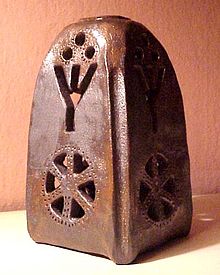Julleuchter

The Julleuchter is an allegedly pagan-Germanic, but actually reconstructed cult object within the framework of the neo-pagan Germanic worship, which is supposed to symbolize the solstice . It played an essential role in the National Socialist Christmas cult and was also used in the context of the customs of the SS .
Modern origin
Such a candlestick was mentioned for the first time in 1888 in the Swedish magazine "Runa". An original was described that comes from the Halland area in the 16th century and is now exhibited in the local museum. It was copied by the national historian Herman Wirth ("The Ura Linda Chronicle ") in Germany and therefore served as a model for the SS Julleuchter. There are also similar tower chandeliers in Norwegian and Danish museums (Copenhagen). A reference to the Yule Festival cannot be proven.
Use in the time of National Socialism
symbolism
In the time of National Socialism , the Julleuchter was an essential part of the reconstructed "Germanic" religion. The symbolism serves to legitimize the Nazi regime claim: The heart symbol will probably be a recreation of the Lebenspulsars and the Hagall - Rune (younger Futhark) hail and snow symbolize and ideological statement convey that the pattern of events the past affect shaping on the present (in the picture of the devastating hail, which after its melting reveals the green land refreshed). Hagall thus symbolizes the energies that have arisen in the past and are effective up to the present.
use
During the Nazi era, especially with the SS, the solstice ceremony should be carried out as follows: During a certain period (which varies in length from region to region) before the winter solstice, the candle stub from the previous year (which had to be kept in a special vessel throughout the year ) placed in the candlestick. The not yet turned sun is symbolized by the light projection of the heart and rune in the room. The light must never go out. On December 21st at night the burning candle is put on the candlestick - the sun has turned. The candle then stays on the candlestick for different lengths of time. The stub of the last candle remains in that special place to illuminate the next solstice.
Use in the SS
The SS Julleuchter of the Nazi era was a clay candlestick that was decorated with symbols that were supposed to remind of runes and Germanic symbolism that the SS used at celebrations. Especially at the Yule Festival , which the National Socialists propagated instead of the Christian Christmas, Yule candlesticks were lit.
Manufacturing
In 1939, prisoners of the Dachau concentration camp produced 52,635 Julle candles on behalf of the Allach porcelain factory . The information about the specimens manufactured in the modeling workshop of the clinker factory in Neuengamme concentration camp in 1943 amount to 15,116 and approx. 15,000 pieces.
use
The Julleuchter was part of the Germanic-neo-pagan customs of the SS and should be present in daily life:
“The SS man's apartment should be recognized by the fact that one of its corners is intended for his family's celebration. It is intended to bring together those things that remind people of their higher obligations. […] On the chest [that should stand in the corner and contain heirlooms] stand the Julleuchter all year round and all around the Julteller (made of pewter or earthenware) of the individual family members, which they use for all festivals of the year, but also use for birthday, wedding and anniversary of death. […] The wall is decorated with a picture of the Führer and the Reichsführer SS, along with a pedigree and family pictures, memorabilia from times of war and battle. The large SS rune should not be missing. The Jul and SS corner is the indicator of the extent to which the SS man and his wife participate in the customs of the SS. "
It was used in particular as an award by the Friends of the Reichsführer SS .
Use in right-wing extremism
In right-wing extremist circles, the Julleuchter is once again used as a cultic device.
literature
- Wolfgang Benz , Hermann Graml , Hermann Weiß (eds.): Encyclopedia of National Socialism (= digital library. 25); CD-ROM; Directmedia Publ., Berlin 2000, ISBN 3-89853-125-2 .
swell
- ↑ The website NS-Kunst.com calls the Julleuchter “the most essential piece of cultural paraphernalia invented by the SS” in the context of the “contrived neo-pagan 'religion'”.
- ↑ Nordiska Museet, Stockholm, historiska.se
- ↑ Heinrich W. Schild: The Julleuchter of the porcelain manufactory Allach . In: Militaria. Specialist journal for awards, uniforms, military and contemporary history . tape 23 , 6, November-December, 2000, ISSN 0724-3529 , p. 148-162 .
- ↑ Nigel Pennick: The Illustrated Advisor Runes. [to recognize the ancient wisdom of the runes] . Könemann, Cologne 2001, ISBN 3-8290-7508-1 (English: The complete illustrated guide to runes .).
- ^ The Museum of Resistance and Deportation ( Memento of March 13, 2005 in the Internet Archive )
- ↑ Handout from the Wewelsburg District Museum. Archived from the original on September 27, 2007 ; Retrieved March 17, 2013 .
- ↑ Wolfgang Benz, Hermann Graml, Hermann Weiß: Encyclopedia of National Socialism. Klett-Cotta, 1997, ISBN 3-608-91805-1 , p. 538.
- ^ SS Upper Section West: The organization of festivals in the course of the year and life in the SS family. Wuppertal undated, p. 41, KW, archive, 70/1/3/7; quoted from lwl.org (PDF; 5.1 MB), p. 217.
- ↑ Andrea Röpke , Andreas Speit , Maik Baumgärtner : a girl thing! Women in the neo-Nazi scene. Berlin 2011, pp. 16-18.
Web links
- The Julleuchter - an invented tradition ( Memento from December 22, 2010 in the Internet Archive )
- allach.ru on the neo-pagan tradition of the Julleuchter ( Memento from September 3, 2011 in the Internet Archive ) (Russian)
